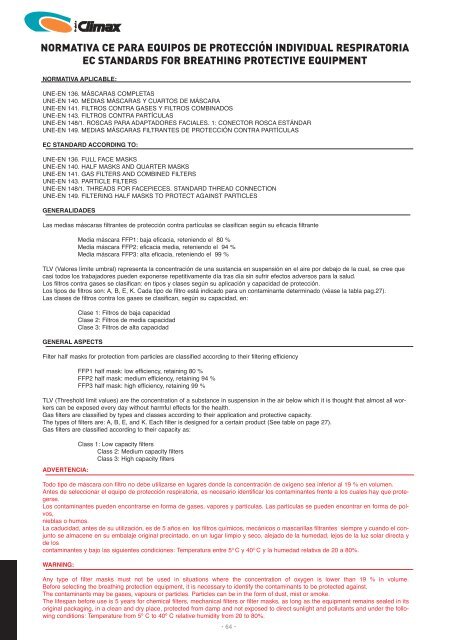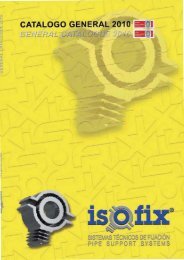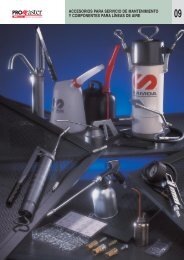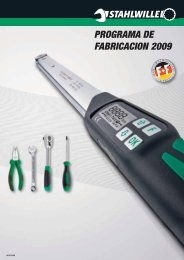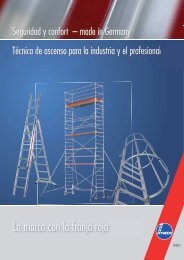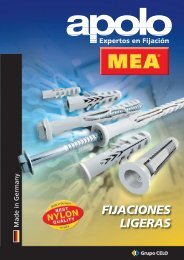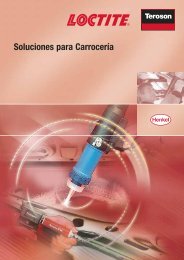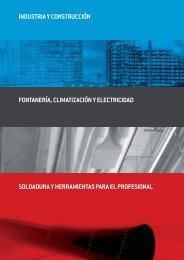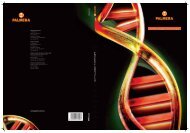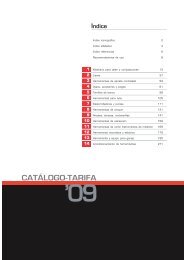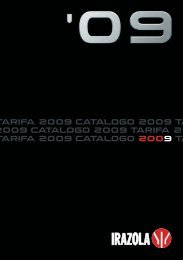You also want an ePaper? Increase the reach of your titles
YUMPU automatically turns print PDFs into web optimized ePapers that Google loves.
NORMATIVA CE PARA EQUIPOS DE PROTECCIÓN INDIVIDUAL RESPIRATORIAEC STANDARDS FOR BREATHING PROTECTIVE EQUIPMENTNORMATIVA APLICABLE:UNE-EN 136. MÁSCARAS COMPLETASUNE-EN 140. MEDIAS MÁSCARAS Y CUARTOS DE MÁSCARAUNE-EN 141. FILTROS CONTRA GASES Y FILTROS COMBINADOSUNE-EN 143. FILTROS CONTRA PARTÍCULASUNE-EN 148/1. ROSCAS PARA ADAPTADORES FACIALES. 1: CONECTOR ROSCA ESTÁNDARUNE-EN 149. MEDIAS MÁSCARAS FILTRANTES DE PROTECCIÓN CONTRA PARTÍCULASEC STANDARD ACCORDING TO:UNE-EN 136. FULL FACE MASKSUNE-EN 140. HALF MASKS AND QUARTER MASKSUNE-EN 141. GAS FILTERS AND COMBINED FILTERSUNE-EN 143. PARTICLE FILTERSUNE-EN 148/1. THREADS FOR FACEPIECES. STANDARD THREAD CONNECTIONUNE-EN 149. FILTERING HALF MASKS TO PROTECT AGAINST PARTICLESGENERALIDADESLas medias máscaras filtrantes de protección contra partículas se clasifican según su eficacia filtranteMedia máscara FFP1: baja eficacia, reteniendo el 80 %Media máscara FFP2: eficacia media, reteniendo el 94 %Media máscara FFP3: alta eficacia, reteniendo el 99 %TLV (Valores límite umbral) representa la concentración de una sustancia en suspensión en el aire por debajo de la cual, se cree quecasi todos los trabajadores pueden exponerse repetitivamente día tras día sin sufrir efectos adversos para la salud.Los filtros contra gases se clasifican: en tipos y clases según su aplicación y capacidad de protección.Los tipos de filtros son: A, B, E, K. Cada tipo de filtro está indicado para un contaminante determinado (véase la tabla pag.27).Las clases de filtros contra los gases se clasifican, según su capacidad, en:GENERAL ASPECTSClase 1: Filtros de baja capacidadClase 2: Filtros de media capacidadClase 3: Filtros de alta capacidadFilter half masks for protection from particles are classified according to their filtering efficiencyFFP1 half mask: low efficiency, retaining 80 %FFP2 half mask: medium efficiency, retaining 94 %FFP3 half mask: high efficiency, retaining 99 %TLV (Threshold limit values) are the concentration of a substance in suspension in the air below which it is thought that almost all workerscan be exposed every day without harmful effects for the health.Gas filters are classified by types and classes according to their application and protective capacity.The types of filters are: A, B, E, and K. Each filter is designed for a certain product (See table on page 27).Gas filters are classified according to their capacity as:Class 1: Low capacity filtersClass 2: Medium capacity filtersClass 3: High capacity filtersADVERTENCIA:Todo tipo de máscara con filtro no debe utilizarse en lugares donde la concentración de oxígeno sea inferior al 19 % en volumen.Antes de seleccionar el equipo de protección respiratoria, es necesario identificar los contaminantes frente a los cuales hay que protegerse.Los contaminantes pueden encontrarse en forma de gases, vapores y partículas. Las partículas se pueden encontrar en forma de polvos,nieblas o humos.La caducidad, antes de su utilización, es de 5 años en los filtros químicos, mecánicos o mascarillas filtrantes siempre y cuando el conjuntose almacene en su embalaje original precintado, en un lugar limpio y seco, alejado de la humedad, lejos de la luz solar directa yde loscontaminantes y bajo las siguientes condiciones: Temperatura entre 5 O C y 40 O C y la humedad relativa de 20 a 80%.WARNING:Any type of filter masks must not be used in situations where the concentration of oxygen is lower than 19 % in volume.Before selecting the breathing protection equipment, it is necessary to identify the contaminants to be protected against.The contaminants may be gases, vapours or particles. Particles can be in the form of dust, mist or smoke.The lifespan before use is 5 years for chemical filters, mechanical filters or filter masks, as long as the equipment remains sealed in itsoriginal packaging, in a clean and dry place, protected from damp and not exposed to direct sunlight and pollutants and under the followingconditions: Temperature from 5º C to 40º C relative humidity from 20 to 80%.• 64 •


